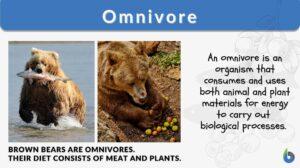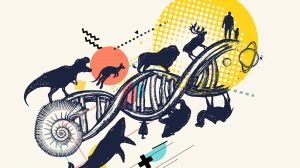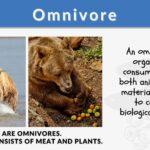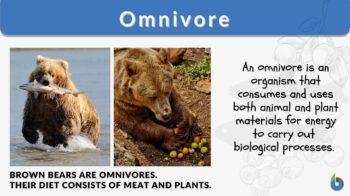
Omnivore
n., plural: omnivores
[ˈɒmnɪvɔː(ɹ)]
Definition: organism that eats both plants and animals
Table of Contents
Organisms need to eat food in order to gain energy and survive in the ecosystem. Often, living things are categorized by how they obtain their food (energy). For plants, they create their own, so they are known as autotrophs. However, animals usually must find and consume their food. They are categorized as herbivores, carnivores, and omnivores.
Herbivores consume plants and carnivores consume meats and/or fish. So what do omnivores eat? What is an omnivore? To define omnivores, one can simply say that these are animals that eat both plants and animals.
Omnivore Definition
Omnivores are organisms whose diet consists of both plant and animal stuff. They vary from the herbivores and the carnivores. Omnivores get the majority of their food from plants and animals. Other food sources, including algae, fungus, and bacteria, may also be included in their diet. Omnivores are also known as all-eaters due to their diverse dietary sources.
The omnivore definition in biology states that:
“An omnivore is a creature that consumes a wide range of materials on a regular basis, such as fungi, algae, plants, and animals”.
This definition may probe many questions. Are humans omnivores? Yes, humans are naturally omnivores though many may choose to be vegans who do not eat meat or meat-based products.
Humans are omnivores as shown by the type of teeth they possess in their body. Omnivore teeth consist of both canines and incisors for tearing meat and also molars for grinding plants. These are omnivore adaptations.
You may want to read this: Humans are Omnivores – Evidence
Many omnivores have biological adaptations that allow them to consume a wide range of foods. They have adapted several carnivore and herbivore features. Raccoons, like many carnivores, have powerful front teeth that allow them to tear apart mice and other tiny prey. Raccoons, like many herbivores, have big molars that aid in plant chewing. Raccoons have swift paws and long fingers that they may utilize to catch animals as well as access a variety of fruits and other plant items.
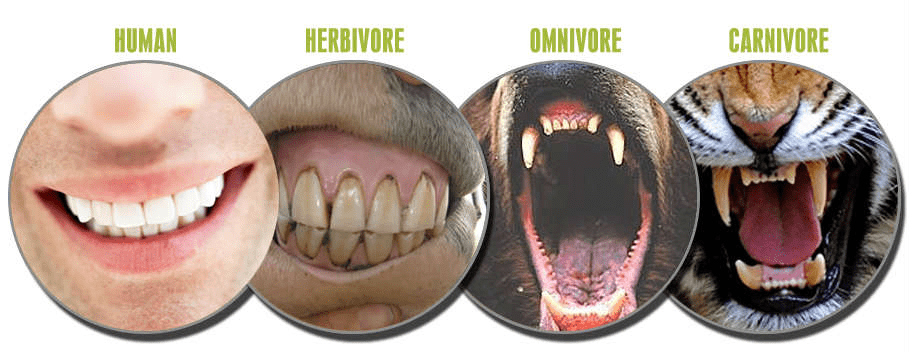
Etymology and Definitions
The word omnivore comes from the Latin words omnis, which means “all,” and vora, which means “to consume or devour.” It was invented by the French and then popularized by the English in the 1800s. Previously, the omnivore classification was based on behavior, i.e., by simply “having a diet of both animal and vegetable products”.
With the advancement of improved scientific skills in domains like as gastroenterology, scientists have developed a standardized variety of omnivores used for designating a species’ genuine capacity to extract energy and nutrients from materials. As a result, two context-specific meanings have been conditioned.
- Behavioral: This term refers to whether a species or individual actively consumes both plant and animal resources. The terms “omnivore” and “omnivory” are frequently used in nutrition, sociology, and psychology to contrast stereotypical extremely diversified human eating habits from limited diet patterns that omit key food groups.
- Physiological: This term is frequently used in academia to describe creatures that can acquire energy and nutrients from both plant and animal sources.
The traditional and behavioral definition of an omnivore is limited in taxonomic utility because the diet, behavior, and phylogeny of one omnivorous species may be very different from that of another: for example, an omnivorous pig digging for roots and scavenging for fruit and carrion is taxonomically and ecologically distinct from an omnivorous chameleon that eats leaves and insects.
The word “omnivory” is also not necessarily inclusive because it excludes mineral foods such as salt licks as well as the intake of plant and animal material for medicinal purposes that would not otherwise be ingested (i.e. zoopharmacognosy) in non-omnivores.
Omnivores are animals that include both plant and animal matter in their normal diet. They differ from other animal groups: the herbivores (animals that feed on plant matter) and the carnivores (animals that eat animal matter). Omnivores derive their dietary needs chiefly from plants and animals. They may also incorporate in their diet other food sources, such as algae, fungi, and bacteria. Because of the wide variety of food sources, omnivores are also called all-eaters.
Etymology: The word omnivore came from the Latin “omnivorus”, a combination of “omnis”, meaning “all” or “everything” and “-vorus”, meaning “-eating” or “-devouring”. The condition or act of consuming animal and plant matter or a wide range of material from different trophic levels is referred to as omnivory. The word “omnivorous” is used to describe or pertain to omnivory.
Omnivorous Animals
Are birds omnivores? Yes although not all birds are. With only a few herbivores (e.g., nene and snow goose), many bird species are classified as omnivores as they tend to eat insects apart from their typically plant-based diets. Larger birds like owls and eagles even go as far as to eat small rodents like mice. This is similar to their close relatives, omnivore dinosaurs of which birds are the closest descents.
Are dogs omnivores? A detailed examination of the anatomy, behavior and dietary habits of dogs reveals that they are omnivorous – capable of eating and being healthy with an omnivore diet. Are foxes herbivores, carnivores or omnivores? Foxes are indeed omnivores as well.
Are chimpanzees omnivores? Yes, they are. Chimps — human’s closest evolutionary relatives — are omnivores. These show that ancestor omnivores can exist. Many other mammals and land animals with the same or similar ancestry not only share features and processes but also similar eating habits as well.
What are 3 examples of an omnivore? There are rainforest omnivores (animals that live in the rainforest that are omnivorous) as well as just simply omnivores like pig omnivores and cat omnivores. More omnivore animals and omnivore examples can be seen in the list of omnivores as follows:
- Squirrel – omnivore
- Bear – omnivore
- Gorilla – omnivore
- Fox – omnivore
- Wolves – omnivore
- Mouse – omnivore
- Elephants – omnivores
- Hedgehog – omnivore
- Racoon – omnivore
- Mackay – omnivore
- Giraffe – omnivore
- Skunk – omnivore
- Zebra – omnivore
- Lizard – omnivore
Omnivorous Plants
Bladderworts (genus Utricularia) are unlike most plants. Aside from producing food by photosynthesis, bladderworts feed. They have a fascinating “meat” diet consisting of minute soft-bodied animals, such as aquatic worms, mosquito larvae, newborn tadpoles, fish fry, etc. When they want to “eat“, they release sugary chemicals that attract their prey. Using special trapping hollow sacs, called “bladders“, they suck in their “food”.
The bladders are attached to underwater stolons. When the prey comes close and somehow triggers the hairs of the sealed bladder, the nearby water together with the prey gets sucked in as the valve of the bladder opens within 1/460 of a second. The bladder shuts off and the prey that is trapped inside gets digested by the digestive enzymes released into the bladder. Nutrients are then absorbed.
Recent studies found that the bladderwort diet isn’t just meat. Scientists found that their bladders would also take in algae and pollen grains. For this, we can therefore regard bladderworts as omnivorous plants. (Bladderworts, 2022)
Watch this vid of bladderworts feeding.
Classification, Contradictions, and Difficulties
Despite Carnivora being a taxon for species categorization, there is no counterpart for omnivores because they are found in numerous taxonomic clades.
Carnivorous animals are not all present in the Carnivora order, and not all Carnivora species are carnivorous. (Carnivora members are properly known as carnivorans.)
It is common to see physiological carnivores devouring plant materials or physiological herbivores ingesting animal materials, such as dogs consuming grass and animals like deer hunting and consuming birds. This would make them omnivores from a behavioral sense, but from a physiological standpoint, this might be due to zoopharmacognosy. To be described as omnivorous, the organism must be able to receive both energy and nutrients from plant and animal components.
As a result, such creatures can still be categorized as carnivores and herbivores when they acquire nutrition from sources that do not appear to complement their categorization. For example, it is generally known that animals such as cattle as well as giraffes and camels would gnaw on bones, ideally dry bones, in order to get specific minerals and nutrients. Felines, who are obligate carnivores, consume grass sometimes to vomit indigestible (e.g., hair, bones), to assist in hemoglobin formation, and as a laxative.
Animals that were previously categorized as carnivorous have been shown to consume plant material on occasion. For example, in 2013, it was proposed that American alligators (Alligator mississippiensis) may be biologically omnivorous after research into why they consume fruits on occasion. It was hypothesized that alligators ate fruits both accidentally and on purpose.
The term “life-history omnivores” refers to creatures that modify their food choices during their life cycle. Some animals, such as grazing waterfowl such as geese, are known to eat mostly animal tissue at one stage of their existence and mostly plant stuff at another.
Many insects, such as beetles in the Meloidae family, start off consuming animal tissue as larvae but eventually switch to eating plant stuff. Similarly, many mosquito species feed plants or other detritus in their early stages, but as they grow, males continue to eat plant debris and nectar; females (such as those of Anopheles, Aedes, and Culex) also need blood to breed efficiently.
Omnivorous Species
General characteristics and adaptations for omnivory
Both animal and plant materials are the main food in an omnivorous diet. Animals with this type of diet have distinct characteristics.
- Omnivores lack the specialized storage and digestive sacs (e.g. crops and fermenting vats) that are common in herbivores.
- Omnivores do not have the sharp long teeth of carnivores that the latter use for capturing and tearing out the flesh of their prey. Similarly, herbivores do not have carnivorous teeth since they do not need to chase down their food. Nevertheless, some herbivores, e.g. beavers, can grow their teeth continuously throughout their lifetime. That is because some plant materials (e.g. cellulose) are highly abrasive to their teeth. (NCSU.edu, 2022)
- Omnivores cannot regrow teeth as many times as some herbivores can. Nevertheless, their teeth are efficient for opening fruits and eating less abrasive plant material. (NCSU.edu, 2022)
Omnivorous mammals
In the wild, many animals, including hominids, pigs, skunks, sloths, hamsters, and rats, are omnivorous.
Most bear species are omnivores, although individual diets can range from nearly entirely herbivorous (hypocarnivore) to almost entirely carnivorous (hypercarnivore), depending on local and seasonal food availability. Polar bears are carnivores, both taxonomically (they belong to the order Carnivora) and behaviorally (they subsist on a largely carnivorous diet).
Because plants and animals digest differently, there is often a predilection for one kind of food depending on the species of bear.
Canines such as wolves, dogs, dingoes, and coyotes consume some plant stuff but have a general inclination and are evolutionarily inclined to meat. The maned wolf, on the other hand, is a candid and their diet consists of 50% plant-based materials, naturally.
Squirrels, like other arboreal animals, are predominantly granivores that eat nuts and seeds. However, squirrels, like nearly other mammals, eagerly ingest animal food when it becomes available. The American eastern gray squirrel, for example, has been imported to portions of the United Kingdom, continental Europe, and South Africa. Its impact on nesting bird populations is typically severe due to egg and nestling eating.
Other species
Birds are omnivorous, with meals ranging from berries and nectar to insects, worms, fish, and small rodents. Cranes, cassowaries, chickens, crows and related corvids, kea, Rallidae, and rheas are a few examples. Furthermore, certain lizards (such as the Galapagos Lava Lizard), turtles, fish (such as piranhas and catfish), and invertebrates are omnivorous. When accessible, many herbivorous species will happily consume little amounts of animal food. Although this is usually insignificant, omnivorous or herbivorous birds, such as sparrows, may frequently feed their young insects when food is most needed for growth.
Close investigation reveals that nectar-feeding birds such as sunbirds rely on ants and other insects found in flowers not for a higher protein supply, but for vital elements such as cobalt/vitamin b12 that nectar lacks. Similarly, several monkey species consume maggoty fruit, sometimes clearly preferring it over sound fruit. When to refer to such creatures as omnivorous or not is a matter of context and emphasis, not terminology.
Humans Evolved into Omnivores
As mentioned earlier, human beings are omnivores. Our teeth show how intensely this is true: humans have biting/tearing/ripping incisors and canines (like predators) as well as chewing molars (like herbivores). Omnivores are animals with a varied set of teeth.
Humans do not contain cellulases or cellulosic symbionts chemically, which are typically found in many herbivores. However, humans have plenty of proteases that are seen in carnivores. But we do have sucrases, which allow us to digest fruits.
Humans require vitamin B12 to thrive, which can only be obtained from animals or certain microbes (vegans must supplement their diet). We also need vitamin C, which is found in citrus fruits and organ meat, with the latter being our evolutionary ancestor’s primary supply.
Interestingly, in comparison to other animals, we have relatively robust livers (the detoxifying organ) and a very great capacity to detect rot/decay/decomposition. This shows that we developed as scavengers, devouring dead (but not too deteriorated) corpses slain by other animals.
Finally, our closest evolutionary relatives, chimps, are omnivores. The dominant idea for how humans developed is that we became long-distance runners and sought food by running it down until it was exhausted and that our availability of flesh and protein allowed our brains to evolve faster than they would have otherwise. So consuming meat is a part of our past, as well as our DNA and physiology.
Omnivore Trivia
- Omnivores are sometimes called the “flexible” eaters of the animal kingdom since they can eat both plants and animals.
- Omnivores can be any size or shape. Some omnivores are as small as some ants or as large as Kodiak bears.
- Omnivores are land almost anywhere in ecosystem food chains and food webs. This is because they can be just above the producer or as high as the biggest hunter in the chain.
- Omnivores have a unique digestive system that differs from that of herbivores and carnivores.
Answer the quiz below to check what you have learned so far about omnivores.
Further Reading
References
- Advocate, T. (n.d.). Louisiana Outdoors. The Advocate. Retrieved June 3, 2022, from https://www.theadvocate.com/baton_rouge/sports/outdoors/
- Are Dogs Carnivores or Omnivores? | Hill’s Pet. (n.d.). Hill’s Pet Nutrition. Retrieved June 3, 2022, from https://www.hillspet.com/dog-care/behavior-appearance/are-dogs-carnivores-or-omnivores
- Bear’s Food and Diet. (n.d.). BearSmart.Com. Retrieved June 3, 2022, from https://www.bearsmart.com/about-bears/food-diet/
- Bennett, -Howard J. (2014, September 22). Ever wondered about meat-eating plants? Washington Post. https://www.washingtonpost.com/lifestyle/kidspost/ever-wondered-about-meat-eating-plants/2014
/09/21/1af3e6e6-39d7-11e4-8601-97ba88884ffd_story.html - Bladderworts. (2022). Missouri Department of Conservation. https://mdc.mo.gov/discover-nature/field-guide/bladderworts
- Common Raven. (n.d.). BirdWeb. Retrieved June 3, 2022, from http://birdweb.org/birdweb/bird/common_raven
- Florida Mouse. (2007, August 29). https://web.archive.org/web/20070829052639/http://unitedstatesfauna.com/floridamouse.php
- McArdle, Ph.D., John (May–June 1991). “Humans are Omnivores”. Vegetarian Journal (The Vegetarian Resource Group).
- Ncsu.Edu. (2020). Assignment 12, page 4. http://webprojects.oit.ncsu.edu/project/bio181de/Lab/nutrition/nutrition4.html#act3
- Omnivore | National Geographic Society. (n.d.-a). Retrieved June 3, 2022, from https://education.nationalgeographic.org/resource/omnivore
- Omnivore | National Geographic Society. (n.d.-b). Retrieved June 3, 2022, from https://education.nationalgeographic.org/resource/omnivore
- Omnivore (Agricultural & Resource Economics)—The Encyclopedia of Earth. (n.d.). Retrieved June 3, 2022, from https://editors.eol.org/eoearth/wiki/Omnivore_(Agricultural_%26_Resource_Economics)
Omnivorous Definition—Omnivore—Bird Diets. (n.d.). Retrieved June 3, 2022, from https://www.thespruce.com/omnivorous-bird-diet-386847 - Quora. (n.d.). How Humans Evolved To Be Natural Omnivores. Forbes. Retrieved June 3, 2022, from https://www.forbes.com/sites/quora/2016/12/23/how-humans-evolved-to-be-natural-omnivores/
- Tree Squirrels | The Humane Society of the United States. (2008, December 25). https://web.archive.org/web/20081225030843/http://www.hsus.org/wildlife/a_closer_look_at_wildlife/tree_squirrels.html
- Why Dogs Eat Grass ~ Dr. Richard Orzeck. (n.d.). Retrieved June 3, 2022, from http://www.worldsvet.com/dogseatgrass.html
- Wildman, R. E. C., & Medeiros, D. M. (1999). Advanced Human Nutrition. CRC Press.
Wolf Park—Wolves. (2015, November 20). https://web.archive.org/web/20151120012513/http://wolfpark.org/oldsite/aboutwolves.shtml - wonderclub, wildlife. (n.d.). Eastern Chipmunk. Https://Wonderclub.Com/. Retrieved June 3, 2022, from https://wonderclub.com/Wildlife/mammals/easternchipmunk.htm
©BiologyOnline. Content provided and moderated by BiologyOnline Editors.

